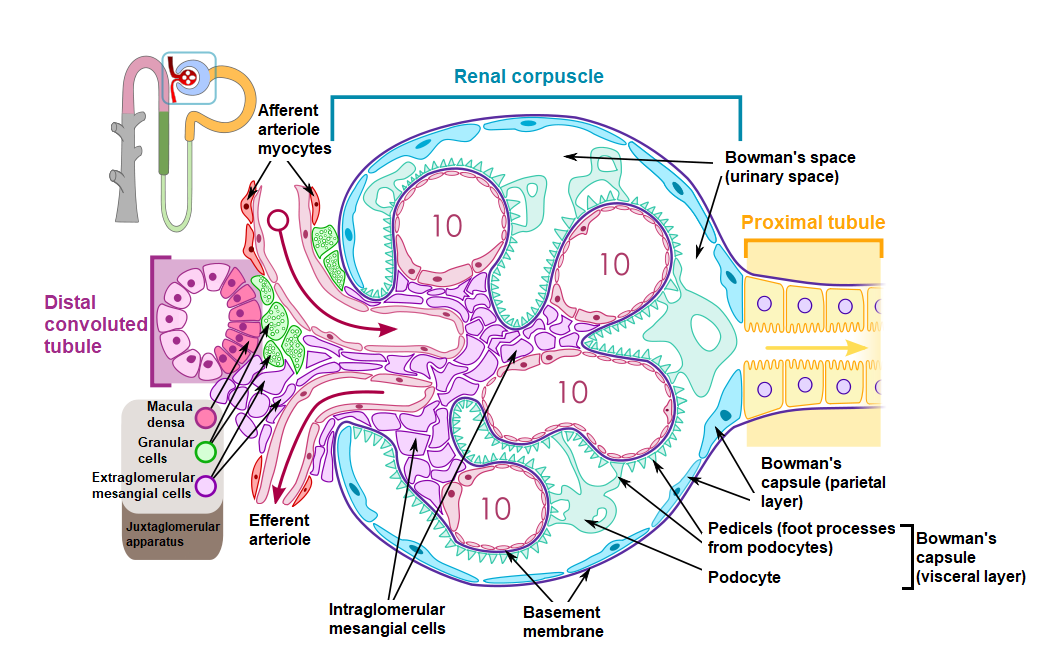
Physiology
Renal
Mesangial cells surround the glomerular capillaries and act to perform all EXCEPT which of the following functions:
Answer:
The glomerulus is interspersed with mesangial cells which act to:- provide structural support for the capillaries
- exhibit phagocytic activity
- secrete extracellular matrix
- secrete prostaglandins
- help regulate blood flow through the glomerular capillaries through their contractile activity
Glomerular Filtration Barrier
Physiology / Renal / Mechanism of Filtration
Last Updated: 29th July 2024
Structure of the Glomerulus
The glomerulus is a ball of capillaries surrounded by the Bowman's capsule.
The glomerulus is interspersed with mesangial cells which act to:
- provide structural support for the capillaries
- exhibit phagocytic activity
- secrete extracellular matrix
- secrete prostaglandins
- help regulate blood flow through the glomerular capillaries through their contractile activity

Structure of the Glomerulus. (Image by OpenStax College [CC BY 3.0 (https://creativecommons.org/licenses/by/3.0)])
Glomerular Filtration Barrier
Plasma is selectively filtered through the glomerular capillary wall into the Bowman's capsule. The solution that arrives in the Bowman's capsule is called ultrafiltrate which then passes into the proximal tubule.
Selective filtration is dependent on the filtration barrier, which has three main layers:
- The glomerular capillary endothelium
- Perforated by pores (fenestrations) which allow plasma components with a molecular weight of < 7000 Da to pass freely.
- A specialised capillary basement membrane
- Layer of connective tissue containing negatively charged glycoproteins, thought to be the main site of ultrafiltration.
- Modified epithelial lining of the Bowman's capsule
- Single layer of specialised cells called podocytes which have long extensions that engulf the capillaries and numerous foot-like processes (pedicels) directly contacting the basement membrane. The regular gaps between pedicles are called filtration slits. Across these slits, a protein network forms slit pores in the epithelial lining which prevent the passage of larger molecules through this final layer. Podocytes maintain the basement membrane and, like mesangial cells, may be phagocytic and partially contractile.

Glomerular Filtration Barrier. (Image modified by FRCEM Success. Original image by MKomorniczak [CC BY-SA 3.0 , via Wikimedia Commons)
Factors affecting Permeability of the Filtration Barrier
Molecular weight is the main factor in determining whether a substance is filtered or not - molecules < 7000 Da in molecular weight pass freely e.g. glucose, amino acids, urea, ions but larger molecules are increasingly restricted up to 70 kDa, above which filtration is insignificant.
Negatively charged molecules are further restricted, as they are repelled by negative charges, particularly in the basement membrane. Albumin has a molecular weight of 69 kDa and is negatively charged, thus only very small amounts are filtered (and all of the filtered albumin is reabsorbed in the proximal tubule), whereas small molecules such as ions, glucose, amino acids and urea pass the filter without hindrance. This means that ultrafiltrate is virtually protein free, but otherwise has an identical composition of that of plasma.
Report A Problem
Is there something wrong with this question? Let us know and we’ll fix it as soon as possible.
Loading Form...
- Biochemistry
- Blood Gases
- Haematology
| Biochemistry | Normal Value |
|---|---|
| Sodium | 135 – 145 mmol/l |
| Potassium | 3.0 – 4.5 mmol/l |
| Urea | 2.5 – 7.5 mmol/l |
| Glucose | 3.5 – 5.0 mmol/l |
| Creatinine | 35 – 135 μmol/l |
| Alanine Aminotransferase (ALT) | 5 – 35 U/l |
| Gamma-glutamyl Transferase (GGT) | < 65 U/l |
| Alkaline Phosphatase (ALP) | 30 – 135 U/l |
| Aspartate Aminotransferase (AST) | < 40 U/l |
| Total Protein | 60 – 80 g/l |
| Albumin | 35 – 50 g/l |
| Globulin | 2.4 – 3.5 g/dl |
| Amylase | < 70 U/l |
| Total Bilirubin | 3 – 17 μmol/l |
| Calcium | 2.1 – 2.5 mmol/l |
| Chloride | 95 – 105 mmol/l |
| Phosphate | 0.8 – 1.4 mmol/l |
| Haematology | Normal Value |
|---|---|
| Haemoglobin | 11.5 – 16.6 g/dl |
| White Blood Cells | 4.0 – 11.0 x 109/l |
| Platelets | 150 – 450 x 109/l |
| MCV | 80 – 96 fl |
| MCHC | 32 – 36 g/dl |
| Neutrophils | 2.0 – 7.5 x 109/l |
| Lymphocytes | 1.5 – 4.0 x 109/l |
| Monocytes | 0.3 – 1.0 x 109/l |
| Eosinophils | 0.1 – 0.5 x 109/l |
| Basophils | < 0.2 x 109/l |
| Reticulocytes | < 2% |
| Haematocrit | 0.35 – 0.49 |
| Red Cell Distribution Width | 11 – 15% |
| Blood Gases | Normal Value |
|---|---|
| pH | 7.35 – 7.45 |
| pO2 | 11 – 14 kPa |
| pCO2 | 4.5 – 6.0 kPa |
| Base Excess | -2 – +2 mmol/l |
| Bicarbonate | 24 – 30 mmol/l |
| Lactate | < 2 mmol/l |

